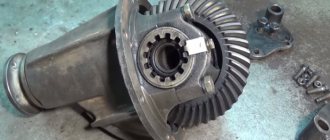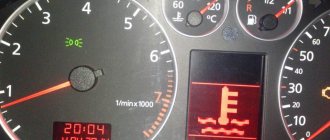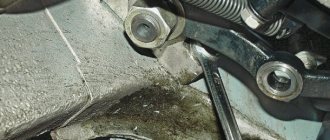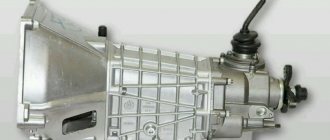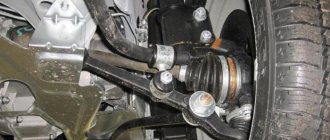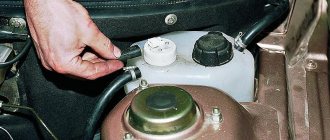According to the recommendation of the AvtoVAZ manufacturer, the coolant in the VAZ 2101-2107 engine must be replaced every 2 years or 45,000 km. Of course, many owners of “classics” do not adhere to this rule, but in vain. Over time, the cooling and anti-corrosion properties deteriorate, which can lead to corrosion in the channels of the block and cylinder head.
In order to drain antifreeze or antifreeze on a VAZ 2107, you will need the following tool:
- Open-end wrench 13 or head
- Sling on 12
- Flathead or Phillips screwdriver
So, before starting this work, it is necessary that the engine temperature is minimal, that is, there is no need to warm it up before this.
First of all, we place the car on a flat, flat surface. The heater control damper must be in the “hot” position. It is at this moment that the heater valve is open and the coolant should completely drain from the heater radiator. Open the hood and unscrew the radiator cap:
We also immediately unscrew the cap from the expansion tank so that the coolant drains from the block and radiator faster. Then we place a container of about 5 liters under the drain hole of the cylinder block and unscrew the bolt, as shown in the photo below:
Since it is quite inconvenient to substitute a large container, I personally took a 1.5 liter plastic bottle and substituted it:
We also unscrew the radiator cap and wait until all the antifreeze or antifreeze drains from the cooling system:
After that, screw back all the plugs except the filler plug and fill the radiator with new antifreeze to the top edge. After this, you need to fill the coolant into the expansion tank. To avoid the formation of an air lock in the cooling system, you need to disconnect the expansion tank hose, as shown in the picture below:
Now we lift the expansion tank up and fill in a little antifreeze so that it flows through the other end of the hose. And at this time, without changing the position of the tank, we put the hose on the radiator. We continue to hold the tank at the top and fill it with antifreeze to the required level.
We start the engine and wait until the radiator fan comes on. Then we turn off the engine when the fan stops working, and after the engine has completely cooled down, we check the antifreeze level in the conservator again. Top up if necessary!
Coolant regulates many important processes in a car. For example, it cools the motor, it affects the temperature sensor and its indicators (during normal operation, the indicator should be at a low level). And in order to maintain all these processes normally, the VAZ 2106 antifreeze must be replaced on time.
Coolant Application
- To maintain normal temperature (sensor) during engine operation.
- To maintain a low temperature (sensor) in the gearbox.
- For lubricating the water pump located in the engine.
- For heating the interior in winter cold.
Replacing antifreeze or antifreeze in a VAZ 2106 car should be done every 45 thousand km or once every two years, depending on the circumstances. Replacement must be made because this substance, like many others, loses its properties over time and succumbs to corrosion. In order to avoid this, you need to change it in time.
Leaks and problems
Cars of this model sometimes have problems associated with the failure of some parts of the cooling system, such as a thermostat or pump. If they break down, they are replaced as an assembly, fortunately they are not expensive. Also, leaking hoses or a cracked expansion tank are considered a common problem, which also needs to be replaced.
But there is another problem with the VAZ 2105, a leaking heater valve. Because of this, there may be a smell of antifreeze in the cabin, wet floor mats on the front passenger side, or the heater may not work.
In cases of boiling or seething antifreeze in the expansion tank, you need to pay attention to 2 things. This is either an air lock or a broken cylinder block gasket.
When determining the problem, in the first case the stove will blow cold. In the second case, there will be either oil in the antifreeze or light smoke from the exhaust pipe.
December 30, 2011
The car is a VAZ 2105 and the coolant is replaced according to the technical inspection card, which in turn neatly hints that the fluid should be changed every 60,000 km. mileage or every two years of vehicle operation. The basic properties of the liquid, namely its ability to withstand low temperatures, as well as anti-corrosion properties, are achieved by adding inhibitory additives to its composition.
If during operation you notice that the liquid has changed its color from bluish or greenish to an orange tint, then it must be changed without delay in the near future, since this is a direct indication that the additives included in its composition have reacted with others chemicals and have lost their anti-corrosion properties. This usually happens when mixing liquids from different manufacturers with different compositions and characteristics (use liquids recommended by the manufacturer).
The procedure for replacing coolant in a VAZ 2105 is as follows:
- We drive the car onto a viewing hole or overpass and remove the engine protective splash guard. You don’t have to remove the splash guard, but to do this you need to come up with either an extension cord to place under the plug, or a large funnel, otherwise the liquid will spill and get on the skin, but it is poisonous and if it gets on the skin, wash it off with warm soapy water.
- Inside the car, you need to open the heater tap, moving the handle to the extreme position so that the liquid drains from the heating radiator of the five.
- We drain the liquid into a previously prepared container by unscrewing the drain plugs in the lower part of the cylinder block and the radiator. You must first unscrew the cap of the radiator and expansion tank so that a vacuum does not form inside the system.
- We drain all the liquid in this simple way, after which we drain the remainder from the expansion tank by unscrewing its fastening and turning it over. We tighten the drain plugs of the radiator and cylinder block.
We pour new antifreeze through the neck of the radiator to the bottom edge, then screw on the cap and add liquid to the expansion tank to the maximum mark. To prevent an air lock from forming in the system during topping up, it is necessary to periodically squeeze the pipes by hand, like a rubber bulb. At this point, the repair work to replace the coolant in the VAZ 2105 has been completed.
How to change coolant
Before replacing the coolant, you need to figure out how to fill it correctly, where, what quantity is needed and what brand. The draining and filling of this substance occurs in the expansion tank, which is located in the engine compartment on the left side of the mudguard on a bracket and secured with clamps.
You will need a volume of 10 liters of antifreeze or antifreeze. Which is better for you? According to reviews, the first one slightly exceeds the indicators; it is also sold in a ready-made form, or it needs to be diluted in a simple proportion (50 to 50). Choose a high-quality and reliable brand.
Before replacing, do not forget to check the temperature indicator (sensor). It is the first criterion that signals immediate replacement. If the temperature is above normal, then start measuring the level. For this:
- Unfasten the rubber strap.
- Unscrew the tank cap and look at the mark (it should be 3-4 mm higher than “min”).
If the level is below normal, then it’s time to start replacing.
Malfunctions and testing of the VAZ-2107 thermostat
Malfunctions:
- does not open at all or opens partially - leads to engine overheating;
- does not close - the engine heats up slowly after a cold start, the engine does not reach operating temperature.
To find out the functionality of the thermostat, you should check at what temperature its main valve begins to open, as well as the stroke of this unit. Since the thermostat itself is mounted in a non-separable housing, this can only be done accurately using special equipment (for example, the BS-106.000 stand).
The simplest check of the VAZ-2107 thermostat can be performed directly on the car by touch.
In the case of a working thermostat, after starting a cold engine, the lower radiator tank should not heat up immediately, but when the arrow on the coolant temperature gauge is 3–4 mm from the red scale zone, which corresponds to 80–85 °C.
If the radiator starts to heat up immediately, this means that the thermostat is not closing. If it’s later, its valve gets stuck. An overheating engine can be evidence of insufficient valve travel when it does not open completely. In all cases, the thermostat must be replaced.
Drain
To get started, make sure you have all the necessary tools:
- key or head;
- screwdriver;
- container for draining;
- stock of new coolant.
Removing the radiator cap
If your engine is cool, you can start working right away.
- Park the car on a level road.
- Open the hood and remove the radiator cap.
- Unscrew the cap from the tank.
- Place a container for draining (one that can hold at least 5 liters).
- Unscrew the bolt and also the radiator cap. Now you can drain everything.
Heat removal mechanism repair
Before you begin repairing the cooling system, you need to find out the volume of liquid poured into it. But even completely draining the old antifreeze, it will not be possible to fully establish the exact figure. To do this, it is still recommended to refer to the vehicle’s operating manual, where all the necessary regulations and parameters are indicated.
The manufacturer assures that the working volume of the VAZ-2106 engine cooling system is nine liters, but it is worth considering that you need to add about a liter to this volume in order to add antifreeze to the expansion tank to the minimum mark. In addition, a thrifty and prudent driver must have a spare liter container of coolant in the trunk.
Cooler drain
Before any operation on the cooling system, you must first allow the engine to cool to avoid serious injury. Then the liquid filling the system will need to be drained. To do this correctly, you have to figure out how it works.
The cooling system has two stages of operation. They can be called cycles and divided into two circles:
- Big.
- Small.
The small circle is limited by the engine itself and some pipes, and it is intended to ensure that the engine quickly reaches the temperature necessary for proper operation
This is important so that the fuel mixture burns more efficiently with a higher efficiency. When the temperature rises to a certain point, a special valve opens, releasing liquid in a large circle
The purpose of this cycle is to directly cool to an acceptable temperature.
The large circle includes a radiator with a fan, which is turned on by a special thermostat and the air flow cools the system and the engine. All liquid is driven by a pump or pump. It also creates the required pressure in the cooling system.
First of all, the antifreeze is drained from the large circle through the radiator, in the left corner of which there is a special drain valve. To do this, you need to prepare a special container with a wide neck. Then a special plug is unscrewed from the engine itself and drainage occurs from the small circle, that is, directly from the engine.
Correct refilling with antifreeze
After completing the necessary work, all drain holes are closed, and the pipes are put in place, and the VAZ-2106 antifreeze is replaced. The liquid that was drained into the container can be reused by carefully filtering it through cheesecloth before doing so. The cooling system is refilled through the expansion tank.
Before refueling, it is necessary to measure the required amount in order to control the filling of the system. After the engine warms up, the liquid will again leave the expansion tank, which will mean filling a large circle with antifreeze. Next, all that remains is to add the missing liquid to the minimum mark. Overflowing above the level is not recommended, since antifreeze expands when heated, and the pipes or expansion tank may not withstand the pressure created by the pump! After refueling is completed, you must ensure that the cooling system is tight and there are no leaks.
The operation of replacing the coolant in a VAZ-2106 is not that complicated, but it will help you save some time, money, and most importantly, you will have confidence that the work was done efficiently.
Fill in
If the first part of the procedure was successful, then you can safely proceed to the second.
- Tighten the bolt.
- Fill the radiator with the required amount of antifreeze or antifreeze.
- Remove the hose and let the substance flow into it so that it flows out the other side. Lift the tank, insert the hose and pour in completely.
- Turn on the engine before the fan starts.
- Turn it off and check the sensor and level.
- Now tighten the radiator cap and tank cap. Screw on the cap and close the hood.
Done, the replacement in the VAZ 2106 was completed successfully.
Antifreeze or antifreeze for VAZ-2109 and other models
Now let's look at this situation on more modern cars. So, what is better - Antifreeze or antifreeze for the VAZ 2109. Similar questions can also be included here: VAZ-2114 - Antifreeze or antifreeze, VAZ 2115 - Antifreeze or antifreeze.
The situation with these cars is similar to the VAZ-2107 model. That is, antifreeze is standard for these cars, but it is also possible to use antifreeze, but only of certain brands.
Replacing fluid on a VAZ-2110
As for the replacement procedure, let's look at how to replace Antifreeze with VAZ-2110 antifreeze or vice versa:
- The car is installed on the platform and cooled;
- The expansion tank cap is removed, the heater tap is opened, the plugs on the radiator and crankcase are unscrewed, and the waste fluid is drained into a container;
- The plugs are installed in place and flushing liquid or distillate is poured into the system. The engine starts to circulate the fluid;
- The flushing fluid is drained, and then fresh antifreeze or antifreeze is added;
On other specified models, the operation is performed similarly.
And as a result, we note that antifreeze is still better than Antifreeze in its properties, but it also costs more. If you want to take better care of your car, then you should fill it with antifreeze, but only of the appropriate brand. But a feature of our automobile industry is the possibility of system leakage, and replenishing the level of antifreeze can be expensive.
Antifreeze also does a good job, but it needs to be changed more often, but it costs less.
Why does it flow
If the lubricant level in your VAZ 2106 car begins to decrease, then there is a high probability that a leak has occurred and before changing it, you need to “patch” the leak site. Finding it is sometimes not very easy. Try searching in places like:
- clamps (it is possible that they are not clamped well);
- radiator (mechanical damage);
- pump (pump worn out);
- leakage from under the head;
- leak into the cabin.
In some cases, you will have to replace the part, in others you will just have to screw it in, seal it and weld it, but there are also cases when the matter requires serious repairs and you will have to take the car to a service center. Therefore, pay close attention to your car and monitor the level and temperature.
Principle of operation
The main place in a car is not the driver’s seat or even the steering wheel, but the engine. It is even called the heart. And this is not without reason, because the correct functioning of this heart directly determines whether the car will go or not. And in order not to destroy such an important technical unit, it is necessary to maintain a certain temperature and cool it in time.
The operating principle of this system is quite simple, but at the same time technically well thought out. It is connected by pipes to the engine itself, the radiator and the interior heater
To understand the importance of these elements, you need to know their main functions:
- Maintaining the required temperature.
- Engine cooling.
- Warming up the car interior.
In the first case, for engine operation and proper combustion of the fuel mixture, a certain and stable temperature is required. If it is higher or lower, it has a very bad effect on the engine. In the second case, the engine is protected from overheating, which can lead to deformation of some parts inside.
Types of coolants
To absorb heat and remove it from hot spots in the engine, the system requires coolant. There are several types of cooling liquids:
- Water.
- Antifreeze.
- Antifreeze.
But in the harsh realities of the Russian climate, the use of water as a coolant is impractical. And it boils away very quickly, having a rather low thermal conductivity. You don’t even need to mention how it affects the occurrence of corrosion.
Antifreeze is the most common among domestic car owners, but it has some disadvantages, for example, the formation of an oil film inside the vessels and pipes, which prevents normal heat transfer. Accordingly, heat removal becomes ineffective.
The third option has more pros than cons. Firstly, antifreeze begins to crystallize at very low temperatures, that is, it does not freeze, which is why it got its name. This advantage allows the use of antifreeze even in the Far North. Secondly, the thickness of the oil film formed inside the vessels is very small, thanks to which almost nothing interferes with the transfer of heat. This is achieved due to the fact that antifreeze, unlike antifreeze, is made from organic components.
The main disadvantage of antifreeze is its price, especially if you need to replace the entire fluid. Antifreeze wins here, and it is more rational to use it in car models such as the VAZ-2101 or VAZ-2106. In models of the domestic automobile industry with impressive age and mileage, the cooling system often becomes a sore and vulnerable spot. Therefore, the owners of these cars need to know the principle of operation of the cooler and understand how to repair it, which will help avoid spending on services and auto repairmen.
Video “Draining the coolant”
Good afternoon, today we will tell you how to independently replace the coolant in a VAZ-2107 (or any other classic). There is nothing complicated in the procedure for replacing antifreeze in the engine cooling system, the main thing is to adhere to the following recommendations - perform the operation of draining the antifreeze only on a cold engine, you can on a warm one, but in no case on a hot one, this is dangerous, just trying to unscrew the radiator neck cap If it's hot, it can cause burns. So let's get started. We will assume that the engine has already cooled down and we are ready to drain the coolant. We will need a 13 key to unscrew the plug on the block and a 22 key to unscrew the plug or sensor at the bottom of the radiator, depending on the model and configuration of your classic. We also need the antifreeze itself, we used the following coolant:
First of all, unscrew the cap on the radiator neck. Then the antifreeze will drain much faster.
Then unscrew the coolant temperature sensor at the bottom of the radiator:
Or a faucet, depending on the modification of your car (different classic models use different types of radiators)
After the antifreeze has drained from the radiator, or without even waiting for it to finish, unscrew the 13 plug on the block with a wrench:
After all the coolant has drained from both the block and the radiator, we screw back the sensor (plug) and the plug on the block, pull it through carefully, and proceed to filling in new antifreeze. We fill it through the filler neck on the radiator. And here’s another little secret - in order to avoid air locks after filling in new coolant, you need to unscrew and throw off this hose, shown below in the photo:
and pour antifreeze into the system until excess coolant begins to drain from it. That's all, congratulations, you have learned how to change the coolant in your classic , and you have learned how to do this without air locks in the system. If you still have any questions about this procedure, we are waiting for you in our VAZ classic club on the forum .
Possibility of tuning the VAZ 2107 cooling system
You can increase the efficiency of the VAZ 2107 cooling system in various ways. Someone installs a fan from a Kalina or Priora on the radiator, someone tries to better heat the interior by adding an electric pump from a Gazelle to the system, and someone installs silicone pipes, believing that with them the engine will warm up faster and cool down. However, the feasibility of such tuning is highly questionable. The cooling system of the VAZ 2107 itself is quite well thought out. If all its elements are in good working order, the engine will never overheat in the summer, and in winter the cabin will be warm even without turning on the heater fan
To do this, you only need to periodically pay attention to system maintenance, namely:
- fill only high-quality coolant into the engine;
- change the coolant every 50 thousand km with a complete drain and flushing of the system;
- monitor the coolant level and add it if necessary;
- When topping up, never mix antifreeze with antifreeze;
- When replacing faulty elements, use only high-quality certified parts.
Thus, the cooling system of the VAZ 2107 is quite reliable and simple. However, it also needs periodic maintenance, which even an inexperienced car enthusiast can perform.
Thermostat
1 – inlet pipe (from the engine); 2 – bypass valve; 3 – bypass valve spring; 4 – glass; 5 – rubber insert; 6 – outlet pipe; 7 – main valve spring; 8 – main valve seat; 9 – main valve; 10 – holder; 11 – adjusting nut; 12 – piston; 13 – inlet pipe from the radiator; 14 – filler; 15 – clip; D – fluid inlet from the engine; P – fluid inlet from the radiator; N – liquid outlet to the pump
At the thermostat, check the temperature at which the main valve begins to open and the stroke of the main valve.
To do this, install the thermostat on the BS-106-000 stand, lowering it into a tank of water or coolant. Press the bracket of the indicator leg from below into the main valve 9.
The initial temperature of the liquid in the tank should be 73–75° C. Gradually increase the temperature of the liquid by about 1° C per minute with constant stirring, so that it is the same throughout the entire volume of liquid.
The temperature at which the valve begins to open is taken to be the one at which the stroke of the main valve is 0.1 mm.
The thermostat must be replaced if the temperature at which the main valve begins to open is not within 81+5–4 ° C or the valve stroke is less than 6.0 mm.
The simplest thermostat check can be done by touch directly on the car.
Replacing the thermostat VAZ-2107
First, the antifreeze is drained from the cooled engine. Using a slotted screwdriver with a thin blade or pliers, loosen the clamp securing the hose supplying antifreeze from the radiator to the thermostat pipe. Disconnect this hose.
Use a Phillips screwdriver or an 8 mm socket wrench to loosen the clamps securing the hoses to the pipes of the cylinder block and pump. Remove the thermostat along with the hoses.
Disconnect the hoses from the thermostat pipes and put them on the new thermostat. Instead of the tape clamps that were on the hoses, they put on worm-drive clamps without tightening them.
The lower pipe of the thermostat is connected to the hose from the radiator. Connect the remaining hoses. All clamps are tightened. Fill in coolant. Start the engine and check for antifreeze leaks and the operation of the new thermostat.
While driving, any engine tends to heat up. The VAZ 2106 engine is no exception. During normal operation of all systems, the operating temperature of the engine should be no more than 85 - 90%. You can find out the temperature using a special sensor located on the instrument panel.
To prevent the engine from overheating, a cooling system is provided. It is filled with antifreeze or antifreeze, which circulates inside the cylinder block, cooling it. You can take a closer look at the cooling system in this article.
Lada 1995, 71 l. With. — consumables
Shawls
Lada 2105, 2010
98 000 ₽
Mogocha
Lada 2105, 2004
75 000 ₽
Mound
Lada 2105, 2003
44 000 ₽
Irkutsk
Lada 2105, 1997
47 000 ₽
See more cars on Drome
Participate in the discussion can only registered users.
Login Register
This is interesting: How much oil is in the box of Priora 2
A little theory
To transmit force, one of the properties of the fluid is used - its incompressibility. That is, when a force is created on a liquid, its volume does not change, and it acts as a transmitter.
A hydraulic brake drive is more practical than a mechanical or pneumatic one, but it has one drawback - if air gets into the fluid, the transmission of force will be significantly reduced. This is because air, like any gas, is compressible. As a result, the presence of air leads to a change in the volume of the liquid when creating force (due to gas compression). Because of this, the force is no longer transmitted to the actuators, since it is absorbed by the volume change.
It turns out that effective operation of the brakes on a VAZ occurs only until air enters the drive system. And this can happen for several reasons.
Article on the topic - The design of the VAZ brake system
Is the problem in the expansion tank?
There may also be a malfunction in it
Please note a few points:
- Are there any cracks in the tank?
- Does the cork allow air to pass freely?
- Are the clamps tightened securely?
- Is the fluid level within acceptable limits?
Only by answering all these questions will it be possible to talk about whether there are any defects in the expansion tank. If there are cracks in it, then antifreeze will leak through them. These are the reasons for the rise in temperature. Injector or carburetor - it doesn’t matter, the expansion tank must be in perfect condition.
The consequence is that you constantly need to top it up, as the level in the expansion tank will begin to drop. A drop in level is the first step towards overheating. Try to keep it between O and MIN.
In this case, only the antifreeze will circulate normally through the system. The reasons for boiling often lie in the little things. For example, the engine boiled after the driver failed to monitor the antifreeze level.
We perform pumping correctly
Bleeding the clutch must be done immediately after replacing the working cylinder, as well as when the level of brake fluid in the reservoir is low. Work is carried out on bleeding in VAZ 2106, 2101, 2107 cars through a fitting located on the working cylinder.
First, fill the brake fluid reservoir full. Find a partner for this job who will press the clutch pedal inside the car. Take the hose and put it on the fitting of the slave cylinder, then tell your partner to depress the clutch pedal several times. After this, let him press the pedal all the way and do not let go, at this time you should slightly loosen the nut on the fitting to release some liquid and air.
This procedure must be repeated until there are no air bubbles in the liquid flowing out of the hose. After that, add it to the middle mark in the tank and check from time to time to see if it goes away.

